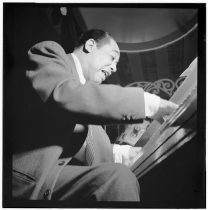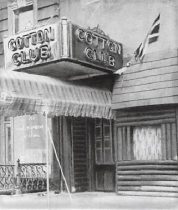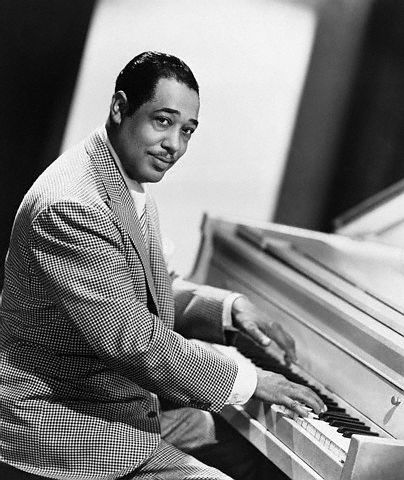The Oxford Dictionary defines jazz as a style of black American music that emerged around the turn of the twentieth century and is marked by improvisation, syncopation, and a regular or powerful rhythm. Jazz is often linked with brass and woodwind instruments, as well as piano, while guitar and violin are also employed; genres include Dixieland, swing, bebop, and free jazz[1]. Although this is its formal definition, most people if asked wouldn’t be able to define it including the great jazz pianist Thelonious Monk; when asked he simply said, “I don’t have a definition of Jazz. You’re just supposed to know it when you hear it.” It has become a cultural art that has brought people together and expanded across America. Although Jazz originated in New Orleans, it would soon find its way to New York City where it could be heard in jazz clubs throughout the city and fostered great musicians after a few decades in New York it would lay claim and become the jazz capital of the world.
One of the first major breakthroughs for jazz in New York City came on January 16th, 1938, when Benny Goodman’s big band played a jazz concert in the famous Carnegie Hall. This was groundbreaking on many levels as it was the first-time people sat in a concert hall to hear swing music rather than dance to it. Furthermore, the Goodman band was one of the first racially mixed bands to perform for a paying audience[2]. The performance would later be called The Famous 1938 Carnegie Hall Jazz Concert. Goodman’s concert was recorded and later published by Columbia Records in 1950 catalog item SL-160. The songs the band played include famous tunes such as One O’Clock Jump, Sing Sing Sing, and Don’t Be That Way featuring solos from Harry James and Jess Stacy just to name a few[3]. The Concert marked a precedent in New York, has introduced jazz to the masses including social elites, with many other jazz musicians following suit and playing in the legendary Carnegie Hall. Soon later, in 1957, jazz singer Sarah Vaughan would highlight an event in Carnegie Hall and even had a piece written about her in the New York Times. The Times described her performance as “electrifying” and called her voice “the finest voice ever to be applied to jazz.[4]”
Jazz has always had a way of breaking down barriers, and it was no different in New York City. While Jazz began booming in the Harlem Renaissance “Jazz Age[5]” many African Americans began being able to express themselves through jazz which led to the rise of many predominate jazz musicians such as Duke Ellington. Edward Kennedy Ellington, nicknamed Duke, was an African American Composer and pianist who started a jazz band in New York City called the Washingtonians. Duke Ellington was one of the most influential creative forces in twentieth-century music. It is impossible to overestimate his impact on classical music, popular music, and, of course, jazz. He was invited to the White House in 1931, and his band launched its first European tour in 1933, which was a big success. Ellington’s artistic development continued in the years after, and the quality of his ensemble improved as well, reaching what many believe to be a pinnacle from 1939 until the early 1940s[6]. His band quickly began gaining fame and Duke Ellington followed in the footsteps of Benny Goodman’s band and played with his band in Carnegie Hall. It would be the first time he would perform at the hall, and it was covered in the New York Times. The times had nothing but praises for Duke Ellington calling his music, “always distinctive, made with subtlety and with a tremendous flair for rhythm and color.[7]” New York City gave Ellington a home where he would expand his creative style, and most importantly during his early career gave Ellington a place for him to play, the Cotton Club.

Another jazz musician who frequented New York City jazz clubs was none other than Louie Armstrong, an American trumpeter and vocalist. Armstrong moved to New York in 1924 and was offered a job at the Cotton Club which he turned down because he thought the pay was too low. Ironically enough the job went to Duke Ellington who used the opportunity to launch his career and would prove to be a pivotal steppingstone[8]. Instead, he would join Fletcher Henderson’s Orchestra, New York City’s leading African American dance band at the time. Armstrong joined Henderson in the fall of 1924 and made an immediate impression with a series of solos that introduced the band to the notion of swing music. Henderson and his arranger, Don Redman, were both influenced by Armstrong, who began incorporating Armstrong’s swinging vocabulary into their arrangements, converting Henderson’s quintet into what is often recognized as the first jazz big band. Armstrong would go on to record several songs which would later become his big hits, with his wife who played the piano, and three other musicians to form Armstrong’s Hot Five[9].
The Cotton Club was Cotton Club, a legendary nightspot in the Harlem district of New York City that for years featured prominent Black entertainers who performed for white audiences. It opened in 1923 and the club served as the springboard to fame for Duke Ellington, Cab Calloway, and many others. Musical revues including dancers, singers, comedians, and variety acts, as well as a house band, were performed at the Cotton Club. Duke Ellington was the band’s leader from 1927 until 1930, and then again for the next eight years. Through weekly broadcasts on radio station WHN, the Cotton Club, and Ellington’s Orchestra earned national popularity, some of which were recorded and issued on records. Some of the most well-known blues and jazz musicians of the day performed at the Cotton Club, including Ethel Waters, Cab Calloway, Duke Ellington, and others[10]. The club, unfortunately, did not allow African American patrons yet allowed African American performers to get their start performing for all-white audiences.

Another popular jazz club was named Birdland the club was located on Broadway, a block west of the 52nd Street scene, which was a hotspot of jazz in the 1930s and 1940s. Morris Levy and Irving Levy named the first Birdland after alto saxophonist Charlie Parker, also known as “Bird,” who was the club’s headliner. Many jazz superstars, including Bird, were regulars at the club. Count Basie and his smokin’ big band made Birdland their New York headquarters, and George Shearing’s “Lullaby of Birdland” was finally recorded live there. In the early 1960s, John Coltrane’s famous Quartet performed regularly at the club, recording “Live at Birdland.” Symphony Sid Torin, a well-known DJ, earned a reputation for himself by broadcasting live from the club to radio listeners all across the eastern shore. In its first five years, over 1 million people paid $1.50 entry to hear Birdland’s attractions and enjoy its ambiance by heading right to the cabaret area or left to the rigorous listening room. That is unsurprising given the talent on the lineup. Erroll Garner, Bud Powell, Dizzy Gillespie, Miles Davis, John Coltrane, Thelonious Monk, Stan Getz, Lester Young, Charlie Parker, and a long list of other jazz greats have all performed at Birdland[11]. Eugene Smith’s The Jazz Loft Project has pictures taken during the 1920s and 30s and on page 77 Smith provides a picture of Thelonious Monk and details his encounter with him. He says, “Rehearsals started at 3 am. That was the only time everyone could make it. It was after the clubs had closed. Everyone [in the band] was playing at some nightclub somewhere, Birdland or the Royal Roast or something.[12]”
[1] DK Publishing, DK Illustrated Oxford Dictionary (Dorling Kindersley, 2003).
[2] “Benny Goodman,” Benny Goodman (The Carnegie Hall Corporation), accessed April 2, 2022, https://www.carnegiehall.org/About/History/Carnegie-Hall-Icons/Benny-Goodman.
[3] Goodman, Benny/The Goodman Band. Famous 1938 Carnegie Hall Jazz Concert, Columbia Records, 1950. Youtube
[4] “’BIRDLAND STARS’ IN JAZZ CONCERTS: Sarah Vaughan Is Highlight of Two Week-End Midnight Events at Carnegie Hall Switch Is Revelation,” New York Times, February 18, 1957, pp. 24-24.
[5] F. Scott Fitzgerald and Ned Halley, Tales of the Jazz Age (London: Macmillan Collector’s Library, 2016).
[6] “Duke Ellington,” Duke Ellington | Songwriters Hall of Fame (Songwriters Hall of Fame), accessed April 3, 2022, https://www.songhall.org/profile/Duke_Ellington.
[7] Howard Taubman, “The ‘Duke’ Invades Carnegie Hall: Duke Ellington Is Composer as Well as Band Leader. He Calls His Work ‘Negro Music.” How He Turns Out His Tunes. the ‘Duke’ Invades Carnegie Hall.,” The New York Times, January 14, 1943.
[8]James Lincoln Collier, Louis Armstrong: An American Genius (New York: Oxford University Press, 1985), 114.
[9] Armstrong, Louis/Hot Five. “Potato Head Blues”, 1927 Columbia Records
[10] contributed by: Elizabeth Winter, “Cotton Club of Harlem (1923- ) ,” Black Past, September 30, 2019, https://www.blackpast.org/african-american-history/cotton-club-harlem-1923/.
[11] “Birdland History – Birdland Jazz Club,” Birdland Jazz Club – Birdland Jazz Club, April 7, 2021, https://birdlandjazz.com/history/.
[12] W. Eugene Smith and Sam Stephenson, The Jazz Loft Project: Photographs and Tapes of W. Eugene Smith from 821 Sixth Avenue, 1957-1965 (New York: Alfred A. Knopf, 2010),

Your information regarding Source #8 is wrong. The person who was offered the Cotton Club gig was King Oliver.